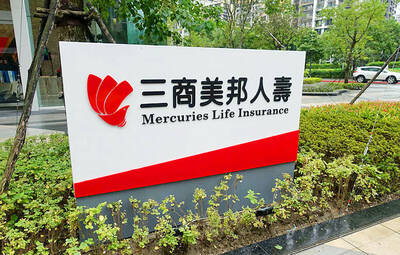The nation’s telecoms are not aligning with the government’s eagerness to put Taiwan on the world’s 5G map as they balk at splurging on the expensive wireless technology that has no guarantees for quick returns.
The nation’s five wireless carriers have clearly said that they would not scramble to roll out 5G services, as they face big challenges ahead, including the absence of a profitable business model to sell the revolutionary technology, in spite of all the use cases that have been suggested.
A 5G use case and adoption survey released last week by Gartner Inc found that Internet of Things applications remain the most popular target use case for 5G, followed by video.
About two-thirds of organizations intend to deploy 5G by 2020, it said.
“We know enterprise clients will be early adopters of 5G technology. We also know the benefits of the technology, but people rarely talk about what will be the potential business models,” Chunghwa Telecom Co (中華電信) president Sheih Chi-mau (謝繼茂) said at a Taiwan Communications Society forum on Dec. 14.
“How to make profits from 5G technology is a real challenge for us,” Sheih said. “Whether 5G can create a blue ocean [for telecoms] remains a question mark.”
Local telecoms each burned up to NT$60 billion (US$1.95 billion) to obtain 4G spectrum and build 4G networks. Four years after the launches in 2014, carriers are still struggling to recover those investments.
Stiff price competition has been blamed for telecoms’ plight.
Over the past two years, 4G average revenue per user has dipped 32 percent to NT$555 in the second quarter of this year, government statistics showed.
Taiwan Star Telecom Corp (台灣之星) president Cliff Lai (賴弦五) made a bold forecast, saying that “5G technology will not be a profitable business by 2025.”
“We cannot even find a business case that would allow us to recover 5G investments in the short term,” Lai said at the forum.
Deploying a 5G network remains two to three times more expensive than the rollout of 4G, as telecoms would have to install many more base stations to ensure Internet connectivity to a massive amount of end devices that is 10 to 100 times faster and has a lower latency than 4G, Taiwan Star Telecom said.
Taiwan Mobile Co (台灣大哥大) is also conservative about jumping into capital-intensive 5G technology.
Company president James Jeng (鄭俊卿) said that the firm would not invest heavily in 5G within three years after the release of the 5G spectrum.
“Within the next three years we do not see any scalable business opportunities that are strong enough to support telecoms’ heavy investments on extensive 5G coverage like we did for 2G, 3G and 4G,” Jeng said.
The National Communications Commission has pushed back the issuance of 5G licenses from next year to 2020 due to technological hurdles and expensive telecommunications equipment in the initial phase.
Local telecoms are likely to commercially launch 5G services in the second half of 2020 or in the first half of 2021, about six months after the release of spectrum, Far EasTone Telecommunications Co (遠傳電信) president Yvonne Li (李彬) said.
In other words, Taiwanese telecoms would lag their global peers such as US telecom giants AT&T Inc and Verizon Communications Inc by about two years in offering 5G services. In the US, major wireless service providers have already begun providing 5G services.
Other markets where significant 5G subscriber volume is expected include South Korea, Japan and China, Telefonaktiebolaget L.M. Ericsson said in an annual mobility report released last month.
Flawed government policy has stalled local telecoms’ investment in 5G and they also learned a harsh lesson during the migration to 4G.
WiMAX service providers, the strongest supporters of a government drive to build a local WiMAX ecosystem, were all forced out of the market in 2015 after admitting defeat in a battle for 4G supremacy with LTE technology.
On the cusp of entering the 5G era, the government aims to build a new 5G supply chain in Taiwan by teaming up with global 5G pioneers like Qualcomm Inc, with the ultimate goal of transforming the nation into a “digital economy.”
The Ministry of Economic Affairs has created a 5G Technology Program Office tasked with spurring collaboration to lead local chipmakers, base station suppliers and networking equipment manufacturers into the global 5G market.
The domestic market could serve as a testing ground for the local 5G supply chain if telecoms spearhead the rollout of 5G services, the ministry said.
However, telecoms have not shown interest in the proposition.
“The ministry has built a bad reputation,” Lai said, citing the WiMAX fiasco. “Taiwan should seek to be a smart follower, rather than a 5G leader.”

France cannot afford to ignore the third credit-rating reduction in less than a year, French Minister of Finance Roland Lescure said. “Three agencies have downgraded us and we can’t ignore this cloud,” he told Franceinfo on Saturday, speaking just hours after S&P lowered his country’s credit rating to “A+” from “AA-” in an unscheduled move. “Fundamentally, it’s an additional cloud to a weather forecast that was already pretty gray. It’s a call for lucidity and responsibility,” he said, adding that this is “a call to be serious.” The credit assessor’s move means France has lost its double-A rating at two of the

AI BOOST: Although Taiwan’s reliance on Chinese rare earth elements is limited, it could face indirect impacts from supply issues and price volatility, an economist said DBS Bank Ltd (星展銀行) has sharply raised its forecast for Taiwan’s economic growth this year to 5.6 percent, citing stronger-than-expected exports and investment linked to artificial intelligence (AI), as it said that the current momentum could peak soon. The acceleration of the global AI race has fueled a surge in Taiwan’s AI-related capital spending and exports of information and communications technology (ICT) products, which have been key drivers of growth this year. “We have revised our GDP forecast for Taiwan upward to 5.6 percent from 4 percent, an upgrade that mainly reflects stronger-than-expected AI-related exports and investment in the third

Mercuries Life Insurance Co (三商美邦人壽) shares surged to a seven-month high this week after local media reported that E.Sun Financial Holding Co (玉山金控) had outbid CTBC Financial Holding Co (中信金控) in the financially strained insurer’s ongoing sale process. Shares of the mid-sized life insurer climbed 5.8 percent this week to NT$6.72, extending a nearly 18 percent rally over the past month, as investors bet on the likelihood of an impending takeover. The final round of bidding closed on Thursday, marking a critical step in the 32-year-old insurer’s search for a buyer after years of struggling to meet capital adequacy requirements. Local media reports

RARE EARTHS: The call between the US Treasury Secretary and his Chinese counterpart came as Washington sought to rally G7 partners in response to China’s export controls China and the US on Saturday agreed to conduct another round of trade negotiations in the coming week, as the world’s two biggest economies seek to avoid another damaging tit-for-tat tariff battle. Beijing last week announced sweeping controls on the critical rare earths industry, prompting US President Donald Trump to threaten 100 percent tariffs on imports from China in retaliation. Trump had also threatened to cancel his expected meeting with Chinese President Xi Jinping (習近平) in South Korea later this month on the sidelines of the APEC summit. In the latest indication of efforts to resolve their dispute, Chinese state media reported that